Bathroom furniture | Why the vanity remains a storage essential
How the vanity has sealed its status not only in storage – but the overall bathroom design - and its influence on the resurgence of the dressing room
How the vanity has sealed its status not only in storage – but the overall bathroom design – and its influence on the resurgence of the dressing room
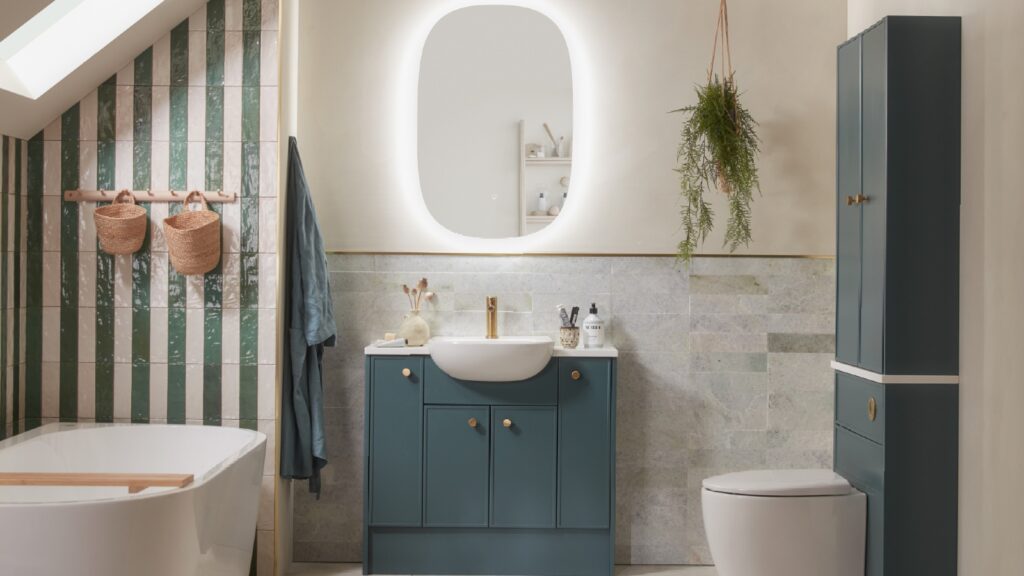
As part of Roper Rhodes fitted furniture offer, Elan is a slim-framed Shaker which is available in a choice of five colours, including Juniper Green
With Duravit celebrating the 30th anniversary of its Starck barrel, with a reimaging of the model, it reflects the time-honoured role of the vanity in modern bathroom spaces.
Of course, few would argue the vanity is rooted further back in history, with the likes of the washstand in the 18th century.
Sponsored Video
However, it goes to show, even in contemporary homes, vanity furniture is long-standing in bathroom design.
Such has been the influence of the vanity, in bathroom design, it has seen Hansgrohe and Vado recently expand their offering into storage including below the basin.
The vanity has even seen the creation of new terminology in bathroom design – the wash place – signifying the important of the storage.
Sales and marketing director at RAK Ceramics Ben Bryden comments: “The vanity unit holds significant importance in the functionality and aesthetic appeal of a bathroom and therefore is an important part of the sale.
“As a central fixture, it sets the tone for the style of the space, influencing the overall ambience and provides essential storage in one of the busiest areas of the bathroom.”
This has been reflected in customer feedback for Tissino, as its product development category manager Sally Bettison offers her thoughts: “A retailer recently remarked, ‘I can’t remember the last time I sold a full pedestal’.
“It’s evident that consumers are seeking more storage space, and brands must stay ahead of this demand to meet customer needs. The majority of our furniture products and sales revolve around bathroom vanity units in various sizes.”
Whereas Julie Lockwood, furniture product manager of Bathrooms to Love by PJH insists vanities top her company’s sales, stating: “Vanity sales are THE most important part of all bathroom furniture sales. All of the Bathrooms to Love furniture collections include choices of vanity unit.”
Suiting all sizes
It is the choices in terms of sizes which allows designers to specify vanity units across all bathroom space – providing essential storage for a clutter-free space.
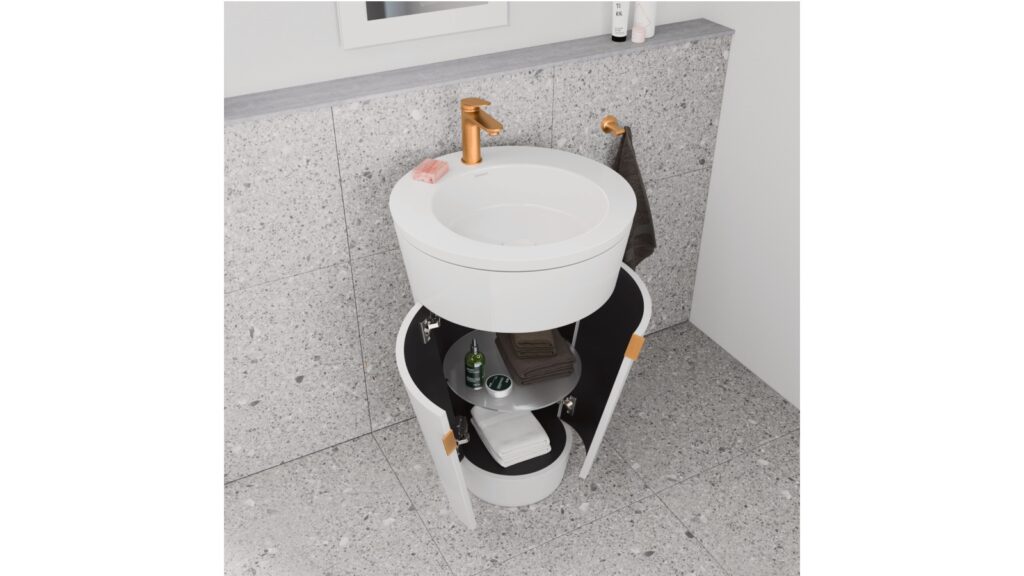
The Duravit Starck Barrel vanity has been introduced with c-bonded wash bowls in matt and gloss black finishes, and in a choice of eight furniture finishes
Cloakroom units are available from 400mm wide up to models for double basins, measuring 1200mm, for large bathroom spaces.
Julie Lockwood of PJH states 600mm wide vanity models are the most popular sizes and she is supported by Sally Bettison of Tissino who states this is the prime choice in her company’s portfolio.
However, she adds reduced vanity with depth units, introduced earlier this year, have also proven popular.
In fact, head of marketing at Woodstock Trading Co Charlotte Tilby says vanities really come into their own for smaller spaces.
She comments: “In the UK, where compact bathrooms are prevalent, it’s unsurprising that compact vanities are the most sought-after option. These space-efficient solutions cater to the practical constraints of smaller bathrooms while still offering essential storage and functionality.”
Style and substance
It’s easy to see why vanities are so popular, especially when they are able to stretch across a range of interior design styles, from classical floorstanding furniture through to contemporary wall-hung modular units – and everything in-between.
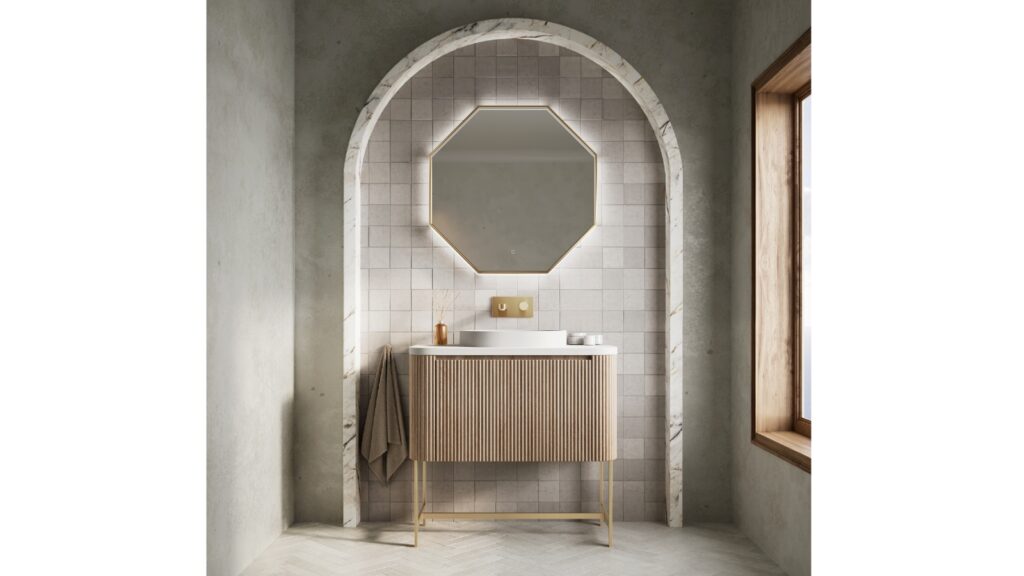
Reflecting the trend for fluid lines and fluted finishes, in the bathroom, Scudo has introduced the Linea Curve
Ben Bryden of RAK Ceramics emphasises interest in wall-hung models, favoured for providing visual lightness in a room, however says designers can’t rule our floorstanding sales: “Wall-hung vanities are gaining popularity for their sleek and modern look, especially in contemporary and minimalist bathrooms.
“They create a sense of spaciousness by freeing up floor space and are easier to clean underneath.
“However, floorstanding vanities with legs or a plinth remain a classic choice, with a traditional charm and versatile in accommodating various bathroom layouts. They often offer more storage options and can be easier to install in existing spaces.”
His view is echoed by Peter Woodward, marketing manager of Harrison Bathroom, who states: “Wall hung units continue to be the fastest-growing category for Scudo, which can offer more opportunities for design and creativity.
“We are also seeing the emergence of units incorporating legs to add sophistication and elegance to any bathroom.”
Charlotte Tilby of Woodstock Trading explains how this dual demand for wall-hung, as well as floorstanding models, has influenced her company’s product development: “While wall-hung vanities are becoming more and more popular, floorstanding remains a staple choice due to ease of installation.
“Our Calypso brand has introduced vanity units that come in both wall-hung and floorstanding configurations, ensuring consumers can choose the option that best suits their needs.”
Inspiring ‘dressing room’
Such has been the growth and development of the vanity; industry experts suggest it has even influenced the ‘dressing room’ trend in the bathroom.
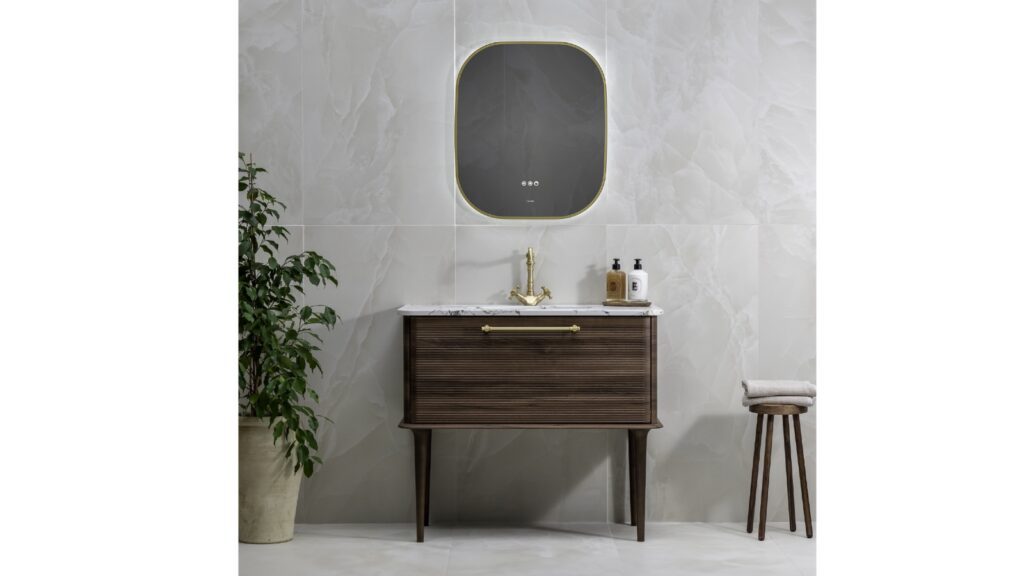
Part of the Calypso brand by Woodstock Trading Co is Petra, which is based on Mid Century furniture and features horizontal fluting. It comes as wall-hung or with legs and in a choice of three finishes
Although nothing new, the dressing room has experienced something of a resurgence as consumers continue to blur the boundaries between practical and functional rooms with cosy and comfortable living spaces.
Charlotte Tilby outlines the influencing role of the vanity unit: “As our bathrooms serve more purposes beyond just hygiene, the demand for versatile storage solution is increasing.
“This reflects a broader trend of repurposing spaces to meet multiple needs. Just like utility rooms are now part of modern kitchens, dressing rooms are making a comeback as homeowners aim to maximise efficiency and convenience in their living spaces.”
And Julie Lockwood of PJH emphatically states the importance of the vanity: “Yes, the vanity unit is influencing the ‘dressing room’ look and this sector has evolved hugely over the last five years”, Julie Lockwood states emphatically.
It could arguably be driven by the vanity looking less like bathroom furniture. I’s out with high gloss white – and in a variety of choice in materials, colour and texture. Just think of the fluted furniture trend – which Sally Bettison says judging by the Milan Design Week is here to stay.
Vanities could even see the expansion of sales outside the ‘traditional’ bathroom domain, as product and marketing manager of Ambiance Bain Karen Jervis states: “Vanity designs, now come with and without basins, which means they no longer need to be confined to the bathroom. Then the look can be completed with other matching storage units.”
Growing sales
Whether in the bathroom or developing sales beyond the traditional boundaries shows no sign of waning, as industry experts states furniture sales are expected to continue to grow – and at the heart of that is the vanity.
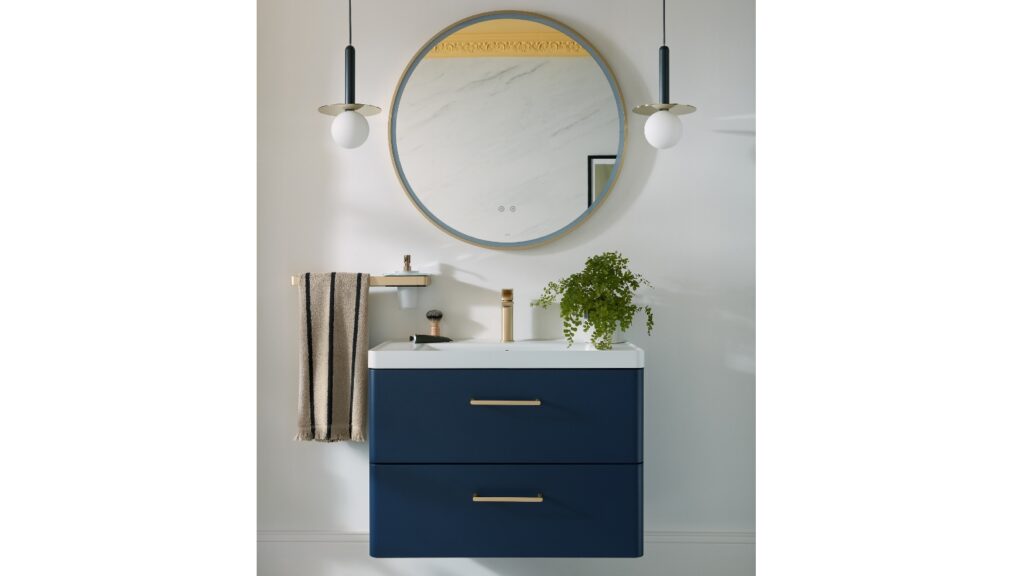
Spanning floormounted to wall-hung vanities, the Cameo Collection from Vado offers furniture in a choice of five finishes
Charlotte Tilby states: “The market for vanities is set for growth, focusing on functionality and style.”
She explains the vanity could offer retailers trade-up opportunities, as she says: “Design-wise, we expect a rise in premium offerings with innovative features and more customisation options, like advanced lighting and better storage.”
Of course, to encourage consumers to spend more on a higher specification vanity, Sally Bettison explains: “Displays are absolutely vital for showcasing a product like a vanity unit, as the additional features need to be seen to be fully appreciated.”
She adds: “Integrated lighting might initially seem like an unnecessary extra, but its overall impact—especially when paired with accessories like mirror lighting—can create a completely different mood that is best experienced in person.”
So take a look at the variety of vanities on offer and consider how they can best be displayed in a showroom to reap sales rewards in what is a lucrative market.
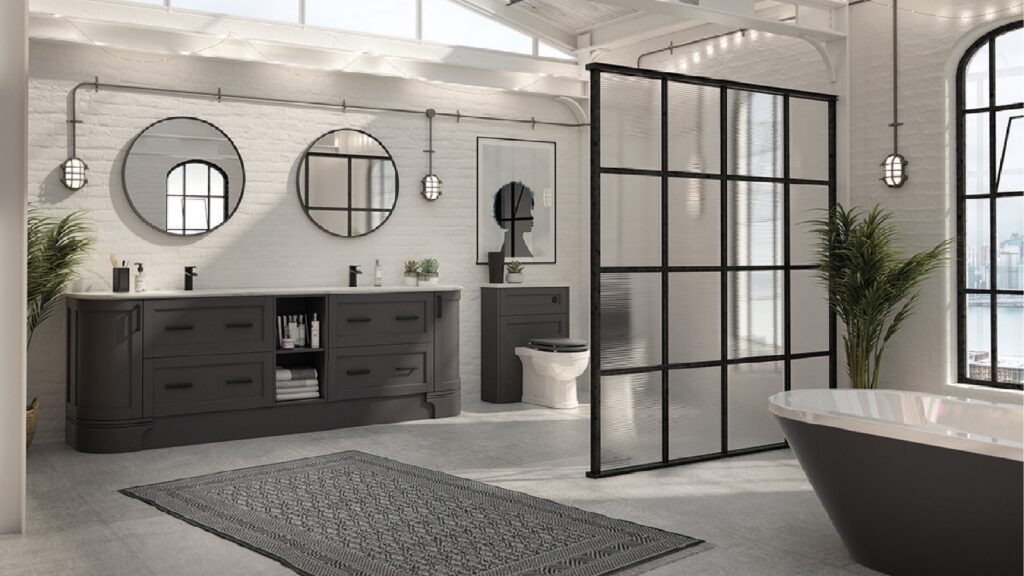
Roseberry painted bathroom furniture, from Utopia, spans from compact units to large curved vanities, floorstanding through to wall-hung models
Related Articles
#socialwall
Sintered stone manufacturer Neolith has launched Calacatta Roma and Cappadocia Sunset, inspired by nature and classical architecture, and for use in kitchens or bathrooms walls, floors, in gardens or facades.

They belong to The New Classtone and Fusioncollections which interpret marble and natural stone, respectively, and boast Neolith’s antibacterial NeolEAT technology.
Inspired by Ancient Rome, Calacatta Roma (pictured top) pays homage to Italian Carrara marble, with ochre and grey veins in a white background.
While the Cappadocia region, in central Turkey, with its rock formations formed by volcanoes and underground cities, has inspired Cappadocia Sunset (pictured below).

Just like all of Neolith’s surfaces, Calacatta Roma and Cappadocia Sunset are resistant to heat and atmospheric conditions, are 100% recyclable, and do not contain added quartz to their formulation.
Mar 14, 2024
JUST OUT: @AcquabellaBath has unveiled a choice of shower grate patterns for its Base and Arq shower trays… https://t.co/kMN83c40Qf
JUST OUT: @FrankeUK unveils Mythos single lever mixers in Swivel Spout and Pull-out Nozzle options. #kitchendesign https://t.co/TSKCAo5r0e
INTERVIEW: Sales and marketing director of @blumuk David Sanders on how the kitchen industry has changed post-pand… https://t.co/k9LIpUhhDF
NEWS: Challenging housing market is driving home improvements, finds new research by @HafeleUK #HomeImprovement… https://t.co/eMB7jludIm
NEWS: British manufacturer @kudosshowersltd acquired by European SanSwiss. #acquisition #manufacturers #bathrooms https://t.co/gpOv7jMevn
NEWS: @HafeleUK announces Richard Curtis as managing director. #newhire #appointment #leadership https://t.co/NP8U5ramOb
NEWS: @officialbikbbi names CT1 sealant manufacturer as corporate sponsor. #installation #installer https://t.co/8zsxs2HI3n
NEWS: @quookeruk named one of fastest-growing companies in North West. #business #Awards https://t.co/9zZ1ZDGrFI
RETAILER FOCUS: Managing director and design director of UK Kitchen Retailer of the Year @KitchensbyJSG Jim Geddes… https://t.co/JhL3vmxwbd
NEWS: Consumers are renovating for long term, with kitchens and bathrooms a priority, finds @HouzzUK… https://t.co/9VhoTUDI0B
PROFILE: Managing Director of Flair Showers Alan Wright talks about the relaunch of the company, creation of a Show… https://t.co/WDMPqDt2Uk
The new @blumuk carbon black LEGRABOX boasts beautifully slim drawer sides, bringing furniture onto trend, easily b… https://t.co/DrEXXWTyQb
NEWS: House of Fraser owner @FrasersGroupPLC enters strategic partnership with @ao, buying a stake in the online e… https://t.co/44N0O9bekn
NEWS: @HowdensJoinery awarded @WhichUK Best Buy for its rigid cabinets and handleless kitchens. #kitchen… https://t.co/rALz8XRHbv
NEWS: @grohe invites 800 guests from around the world to its Grohe X Professional event in Lisbon, Portugal.… https://t.co/2RGjDum980
JUST OUT: Home appliance brand Candy has unveiled the Rapido dishwasher, claimed to be the fastest and most spaciou… https://t.co/mbWn2pJp2C
Newsletter
Sign up to receive our newsletter and we’ll send you details of our latest videos, competitions and much more

